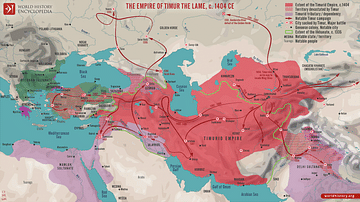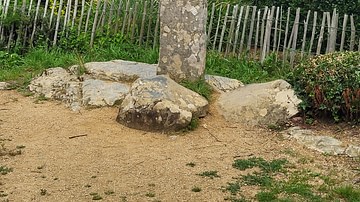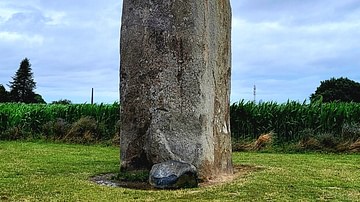Search Images
Browse Content (p. 250)

Image
The Empire of Timur the Lame, c. 1404 CE
A map illustrating the empire and campaigns of Timur (from the Chagatai word for iron) at its biggest extent before his death in 1405. Timur the Lame (Timur-i Leng from Persian, Tamerlane as it had evolved in English or Timūr Gurkānī, son-in-law...

Image
Menhir of Fort La Latte
This granite menhir, located near the Castle of the Rock Goyon (Fort la Latte) in northern Brittany, France, and measuring 2.64 meters, has a very fine obelisk shape. It was broken in two by the film crew of The Vikings in 1957, and the trace...

Image
Champ Dolent Menhir
The Champ Dolent menhir in northern Brittany, France has been standing in its place since the beginning of the Neolithic period. Weighing about 120 tons, it was dug from a granite quarry 4 km away. It is 9.30 m high (just over 30 feet) and...

Image
The Berlin Decree, Pages 2 and 3
Pages 2 and 3 of the Berlin Decree, signed 21 November 1806 by Emperor Napoleon I that kicked off the Continental System embargo on British trade.

Image
French Soldiers Inspect Goods in Leipzig
French soldiers inspect goods in Leipzig in 1806, near the start of Napoleon's Continental System. By Gottfried Heinrich Geißler, 1824.

Image
Smugglers During the Continental System
Smugglers in 1808, defying the Continental System. Etching by John Augustus Atkinson and William Miller, 1808.
National Maritime Museum, Greenwich, London.

Image
Clay Tablet with Linear A Script
A clay tablet from Zakros, Crete inscribed with Linear A script. Still undeciphered, Linear A script was used by the Minoan civilization from c. 1850 to c. 1450 BCE. (Zakros Archaeological Museum)

Image
The Canon of Medicine
The Persian manuscript copy of The Canon of Medicine by Ibn Sina (Avicenna).
Museum and Mausoleum of Avicenna, Hamedan, Iran.

Image
Persian Scholars
Persian Scholar Pavilion, including statues of Avicenna (Ibn Sina) and Biruni, in Vienna International Centre donated by Iran.

Image
Three Pieces of the Antikythera Mechanism
The Antikythera Mechanism (also known as the Antikythera Device), dated to the late 2nd century/early 1st century BCE (roughly 205-60 BCE) is understood as the world's first analogue computer.
National Archaeological Museum, Athens.